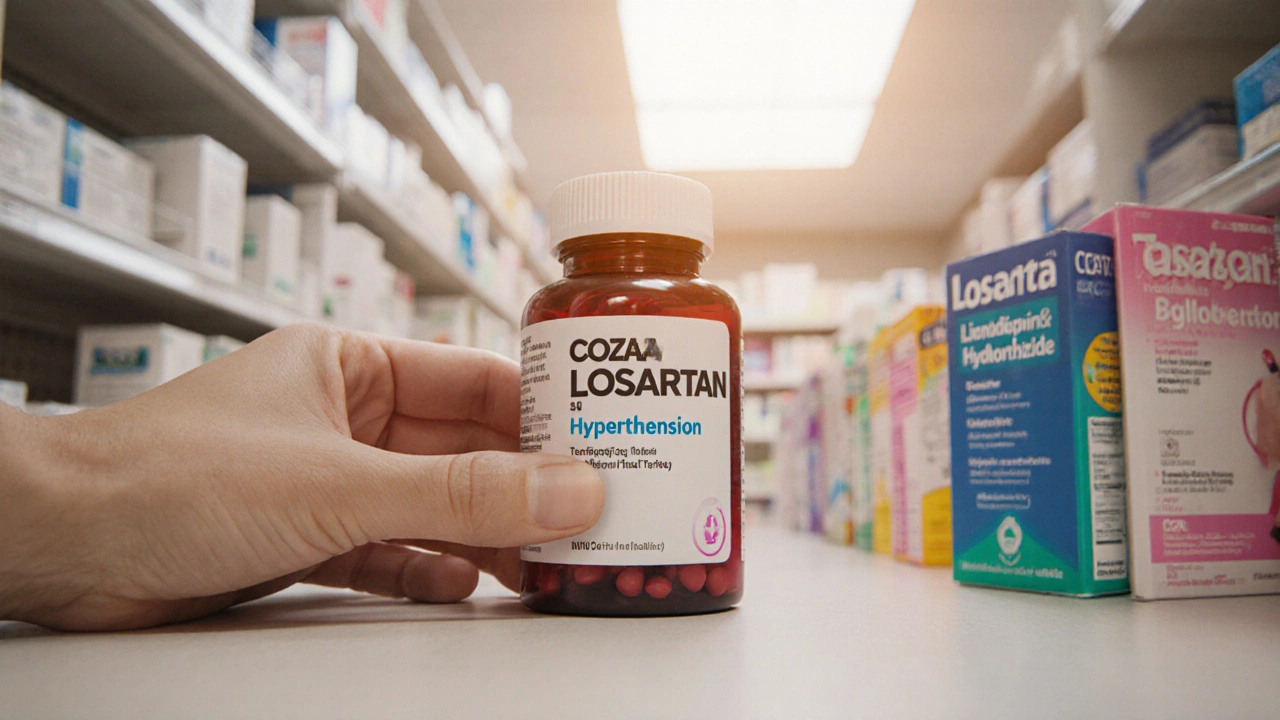Blood Pressure Medication Decision Aid
Find Your Best Blood Pressure Medication
Answer a few quick questions to see which medications may work best for your specific health needs.
When you’re trying to control high blood pressure, the choice of medication can feel overwhelming. Cozaar is the brand name for losartan, an angiotensin II receptor blocker (ARB) that’s been on the market since 1995. But is it the right fit for you, or would another drug work better? This guide walks through the most common alternatives, weighing efficacy, safety, cost, and who benefits most.
Understanding How Losartan Works
Losartan belongs to the ARB class, which blocks the hormone angiotensin II from narrowing blood vessels. By keeping the vessels relaxed, it lowers systolic and diastolic pressure and reduces the workload on the heart.
Key attributes of losartan:
- Typical dose: 50mg once daily, can be increased to 100mg.
- Half‑life: about 2hours (active metabolite lasts 6‑9hours).
- Renal protection: proven to slow progression of diabetic nephropathy.
- Common side effects: dizziness, hyperkalemia, occasional cough.
Top Alternatives to Consider
Below are the most frequently prescribed drugs that compete with losartan for the same indications.
- Telmisartan - another ARB, known for a longer half‑life (24hours) and once‑daily dosing.
- Valsartan - ARB with a solid evidence base for heart‑failure patients.
- Irbesartan - ARB often chosen for patients with chronic kidney disease.
- Lisinopril - an ACE inhibitor, a classic first‑line option.
- Amlodipine - a calcium‑channel blocker, useful when ARBs aren’t tolerated.
- Hydrochlorothiazide - a thiazide diuretic, often combined with an ARB.
Comparison Table: Losartan vs Five Leading Alternatives
| Drug | Class | Typical Daily Dose | Half‑life (hrs) | Cost (AU$ per month) | Top Benefits | Common Side Effects |
|---|---|---|---|---|---|---|
| Losartan | ARB | 50‑100mg | 2 (active metabolite 6‑9) | ≈30 | Renal protection, low cough risk | Dizziness, hyperkalemia |
| Telmisartan | ARB | 40‑80mg | 24 | ≈35 | Once‑daily dosing, good for metabolic syndrome | Headache, GI upset |
| Valsartan | ARB | 80‑160mg | 6‑9 | ≈33 | Proven mortality benefit in heart failure | Fatigue, dizziness |
| Irbesartan | ARB | 150‑300mg | 11‑15 | ≈32 | Strong renal protection | Back pain, sinusitis |
| Lisinopril | ACE inhibitor | 10‑40mg | 12 | ≈28 | Well‑studied, reduces cardiovascular events | Cough, angioedema |
| Amlodipine | Calcium‑channel blocker | 5‑10mg | 30‑50 | ≈25 | Effective for isolated systolic hypertension | Peripheral edema, flushing |

Decision Criteria: When to Pick Losartan Over Others
Think of the choice as a checklist. If you tick most of the boxes, losartan may be your best bet.
- Renal concerns: Losartan’s proven benefit in diabetic nephropathy makes it a go‑to for patients with early kidney disease.
- Low cough risk: Unlike ACE inhibitors like lisinopril, losartan rarely triggers a dry cough.
- Cost sensitivity: Generic losartan is widely available and sits near the low‑end of the price range.
- Drug interactions: Losartan has fewer interactions with NSAIDs and potassium‑sparing diuretics than some ARBs.
- Pregnancy: None of the ARBs, including losartan, are safe in pregnancy; however, they share the same contraindication, so the decision rests elsewhere.
When Alternatives Might Edge Out Losartan
Every medication has a sweet spot. Here’s when you might look beyond losartan.
- Once‑daily convenience: Telmisartan’s 24‑hour half‑life means a single dose covers the whole day, handy for patients who forget doses.
- Heart‑failure focus: Valsartan, especially in the combination sacubitril/valsartan, has a stronger evidence base for reducing mortality in systolic heart failure.
- High potassium levels: If you already have hyperkalemia, an ACE inhibitor (lisinopril) might be avoided, but switching to a lower‑potassium ARB like irbesartan could help.
- Isolated systolic hypertension in older adults: Amlodipine’s long half‑life and vasodilatory effect can better manage the pulse pressure rise seen with aging.
- Combination therapy: Hydrochlorothiazide + losartan is common, but some clinicians prefer a fixed‑dose combo of lisinopril+hydrochlorothiazide for better adherence.
Practical Tips for Switching or Starting Therapy
Changing blood‑pressure meds isn’t a DIY project; always involve your GP or cardiologist. Still, knowing the steps helps you stay organized.
- Get a baseline blood‑pressure reading (average of three readings over a week).
- Ask your prescriber for a wash‑out period if you’re moving from an ACE inhibitor to an ARB (usually 24hours).
- Start the new drug at the low end of its dose range and titrate up every 2‑4 weeks.
- Monitor electrolytes (especially potassium) and kidney function after the first month.
- Keep a side‑effect diary; report persistent dizziness, cough, or swelling promptly.

Safety and Contraindications
All the drugs listed share some red flags, but there are nuances.
- Pregnancy: ARBs (losartan, telmisartan, valsartan, irbesartan) are contraindicated in the second and third trimesters.
- Severe renal impairment: Use with caution; dose adjustments may be needed.
- History of angioedema: Avoid ACE inhibitors like lisinopril; ARBs are safer but still need monitoring.
- Concomitant potassium‑rich foods or supplements: Increases risk of hyperkalemia with ARBs.
Bottom Line: Matching the Right Pill to Your Life
There’s no one‑size‑fits‑all answer. If you need renal protection, low cost, and want to avoid cough, Losartan vs alternatives tilts in losartan’s favor. If you crave once‑daily simplicity, need stronger heart‑failure data, or have specific side‑effect concerns, one of the alternatives may suit you better. Talk to your healthcare professional, review your lab results, and consider lifestyle factors before settling on a regimen.
Frequently Asked Questions
Can I switch from losartan to another ARB without a wash‑out period?
Generally yes. Because ARBs share a similar mechanism, most clinicians will transition directly, but a 24‑hour gap is sometimes recommended to monitor blood pressure and kidney function.
Is losartan safe for people with diabetes?
Absolutely. In fact, losartan is one of the few antihypertensives proven to slow the progression of diabetic nephropathy, making it a preferred choice for many diabetic patients.
Why does losartan cause less cough than lisinopril?
The cough from ACE inhibitors like lisinopril stems from increased bradykinin accumulation. ARBs block the same final step in the renin‑angiotensin system but don’t affect bradykinin, so the cough is far less common.
What should I do if I develop a persistent dry cough on lisinopril?
Contact your prescriber. They may switch you to an ARB such as losartan, which usually resolves the cough within a few days.
Is there any advantage to combining an ARB with a thiazide diuretic?
Combining an ARB like losartan with hydrochlorothiazide can improve blood‑pressure control by addressing both volume overload and vascular resistance. Many patients achieve target pressures with lower doses of each drug, reducing side effects.







Chelsea Wilmer
October 14, 2025 AT 12:26